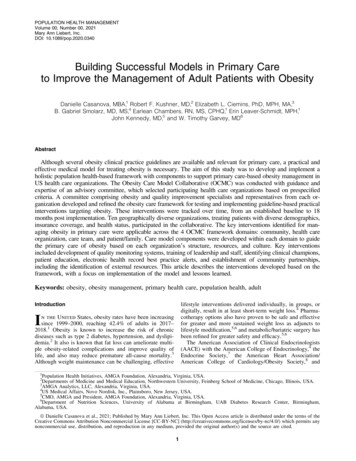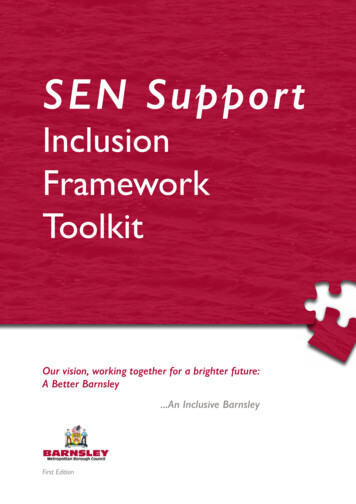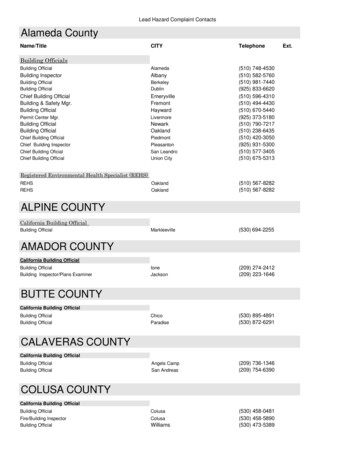
Transcription
POPULATION HEALTH MANAGEMENTVolume 00, Number 00, 2021Mary Ann Liebert, Inc.DOI: 10.1089/pop.2020.0340Building Successful Models in Primary Careto Improve the Management of Adult Patients with ObesityDanielle Casanova, MBA,1 Robert F. Kushner, MD,2 Elizabeth L. Ciemins, PhD, MPH, MA,3B. Gabriel Smolarz, MD, MS,4 Earlean Chambers, RN, MS, CPHQ,1 Erin Leaver-Schmidt, MPH,1John Kennedy, MD,5 and W. Timothy Garvey, MD6AbstractAlthough several obesity clinical practice guidelines are available and relevant for primary care, a practical andeffective medical model for treating obesity is necessary. The aim of this study was to develop and implement aholistic population health-based framework with components to support primary care-based obesity management inUS health care organizations. The Obesity Care Model Collaborative (OCMC) was conducted with guidance andexpertise of an advisory committee, which selected participating health care organizations based on prespecifiedcriteria. A committee comprising obesity and quality improvement specialists and representatives from each organization developed and refined the obesity care framework for testing and implementing guideline-based practicalinterventions targeting obesity. These interventions were tracked over time, from an established baseline to 18months post implementation. Ten geographically diverse organizations, treating patients with diverse demographics,insurance coverage, and health status, participated in the collaborative. The key interventions identified for managing obesity in primary care were applicable across the 4 OCMC framework domains: community, health careorganization, care team, and patient/family. Care model components were developed within each domain to guidethe primary care of obesity based on each organization’s structure, resources, and culture. Key interventionsincluded development of quality monitoring systems, training of leadership and staff, identifying clinical champions,patient education, electronic health record best practice alerts, and establishment of community partnerships,including the identification of external resources. This article describes the interventions developed based on theframework, with a focus on implementation of the model and lessons learned.Keywords: obesity, obesity management, primary health care, population health, adultlifestyle interventions delivered individually, in groups, ordigitally, result in at least short-term weight loss.4 Pharmacotherapy options also have proven to be safe and effectivefor greater and more sustained weight loss as adjuncts tolifestyle modification,5,6 and metabolic/bariatric surgery hasbeen refined for greater safety and efficacy.5,6The American Association of Clinical Endocrinologists(AACE) with the American College of Endocrinology,4 theEndocrine Society,7 the American Heart Association/American College of Cardiology/Obesity Society,8 andIntroductionIn the United States, obesity rates have been increasingsince 1999–2000, reaching 42.4% of adults in 2017–2018.1 Obesity is known to increase the risk of chronicdiseases such as type 2 diabetes, hypertension, and dyslipidemia.2 It also is known that fat loss can ameliorate multiple obesity-related complications and improve quality oflife, and also may reduce premature all-cause mortality.3Although weight maintenance can be challenging, effective1Population Health Initiatives, AMGA Foundation, Alexandria, Virginia, USA.Departments of Medicine and Medical Education, Northwestern University, Feinberg School of Medicine, Chicago, Illinois, USA.AMGA Analytics, LLC, Alexandria, Virginia, USA.4US Medical Affairs, Novo Nordisk, Inc., Plainsboro, New Jersey, USA.5CMO, AMGA and President, AMGA Foundation, Alexandria, Virginia, USA.6Department of Nutrition Sciences, University of Alabama at Birmingham, UAB Diabetes Research Center, Birmingham,Alabama, USA.23ª Danielle Casanova et al., 2021; Published by Mary Ann Liebert, Inc. This Open Access article is distributed under the terms of theCreative Commons Attribution Noncommercial License [CC-BY-NC] (http://creativecommons.org/licenses/by-nc/4.0/) which permits anynoncommercial use, distribution, and reproduction in any medium, provided the original author(s) and the source are cited.1
2other medical professional societies have issued comprehensive evidence-based recommendations to guide healthcare professionals in the treatment of patients with obesity.These guidelines highlight the importance of diagnosing andevaluating patients for weight-related complications and applying treatment approaches involving lifestyle changes andbehavioral therapy, to be used in combination with pharmacotherapy or metabolic surgery, when indicated. The AACEguidelines, in particular, emphasize treatment intensificationbased on the risk, presence, and severity of obesity complications.4 Given the chronic nature of obesity, patients should befollowed up long term and periodically re-evaluated for weightregain and response to weight loss therapy.Despite advances made in therapies and the existingguidelines, meaningful clinical improvements in treatingobesity at a population level are not being achieved. Multiplecausative factors include patient self-blame and stigmatizingattitudes, inaction by health care professionals related to timeconstraints, insufficient knowledge of pathophysiology, lackof reimbursement for diagnosing and/or counseling patients,9and restricted coverage of anti-obesity medications and bariatric surgery by health insurance plans.10 Additionally, social stigma can have a negative effect on patients’ physicaland mental health and create a disinclination to seek care.11In recognition of the complex nature of obesity, patientcentered, multidisciplinary strategies providing individualized care are paramount12,13 and may lead to improvedclinical outcomes, patient adherence and satisfaction, andreduced health care costs and resource utilization.14 Becausethe majority of interactions between patients and health careproviders occur in the primary care setting, and an obesitydiagnosis is known to be associated with weight loss,15 thediagnosis should be considered as a first step in the treatment process. Thus, primary care providers (PCPs) areuniquely positioned to screen patients for obesity and provide access to effective treatment.2 Collaboration betweenPCPs and other specialists in primary care-based models ofhealth care delivery constitutes an effective approach tosustainable weight loss and maintenance.16 However, 30%of patient visits in the primary care setting in 2008–2013 inthe United States resulted in a diagnosis of obesity.17Provision of a care delivery model for practical use in theprimary care setting that incorporates obesity treatmentguidelines thus may improve the uptake and effectivenessof the current interventions for obesity. However, there iscurrently limited information in the literature on obesitycare models that focus on primary care, and no holisticmodel of primary care has been developed specifically forhealth systems. AMGA (American Medical Group Association) is a nonprofit trade association that represents *440of the nation’s multispecialty medical groups and integrateddelivery systems. AMGA provides support in the form ofadvocacy, education, quality performance improvement,research and analytics, and financial and operational assistance. Based on a survey developed by AMGA, which revealed that the majority of the responder health careorganizations (HCOs) did not follow the current recommendations or any particular algorithms for obesity management, the research team identified gaps in knowledge inthe organizations in order to develop a care model within aproposed framework, with the needed flexibility to make itcontextually appropriate to health care systems. The goal ofCASANOVA ET AL.this initiative was to enable HCOs to determine optimalapproaches for integrating the model into their own systemsand, in turn, to develop individual care models. This articlereports on the development and implementation of a population health-based care model to manage obesity in the primarycare setting in the United States and describes key insights (ie,best practices) gathered from across the collaborative.MethodsConcept and organization of the Obesity CareModel CollaborativeThe Obesity Care Model Collaborative (OCMC) was a 35month (from development to data analysis/publication) program development initiative, led by AMGA, that aimed todefine, test, and evaluate a framework for obesity management for primary care in multispecialty medical groups, integrated health systems, and academic medical centers(Figure 1). The objective was to develop a model of care thatcould be tailored to the individual organizations according totheir specific contexts. Ten AMGA-member HCOs were selected by a national advisory committee, based on their abilityto contribute to the development of the framework andmeasures, and their commitment to implement an obesityprogram including a minimum required range of services,either within the HCO or through referral partnerships.A primary care, population-based approach was appliedto obesity management. Each HCO selected 1 representativeto serve as an organization advisor and to participate in 1of 2 committees dedicated to either framework developmentor measure design. The committees included medical andquality directors, program and project managers, professors/researchers, nurses, physicians, and specialists in internalmedicine, endocrinology, or obesity medicine, and members of specialty and advocacy organizations. (Additionaldetails on membership requirements and responsibilities arein Committee member selection and roles in the Supplementary Material, available with the article online).The Framework Committee, which included 12 members, focused on the development of the obesity care modeland its components (ie, interventions) to be tested andimplemented by the participating HCOs (detailed information on processes during implementation are in Modeldevelopment in the Supplementary Material). The MeasuresCommittee, comprising 8 members, developed and refinedoperational and quality performance measures and theirspecifications (ie, diagnosis rates, assessment for complications and complication rates, weight change, use of antiobesity medications, patient-reported outcomes) to be reported by each participating HCO. Results of the measuredevelopment work are reported elsewhere.18 One of themeasures developed in this collaborative, obesity diagnosis,went through a formal testing process to ultimately prepareit for endorsement by the National Quality Forum (S.L.Sampsel, personal communication).Selection of participating centers and initiativesand development and implementation of the modelHCOs responded to a Call for Participation and underwent a robust selection process, which started with the
MODEL OF OBESITY CARE FOR ADULTS IN PRIMARY CARE3FIG. 1. Flow diagram for the development and implementation of interventions under the collaborative. HCO, health careorganization; PDSA, Plan-Do-Study-Act.submission of an application for consideration. Applications were ranked and, if the HCOs met the inclusion criteria, they were interviewed. HCOs were then selected bythe national advisory committee according to predefinedcriteria (see Organization selection and inclusion criteriain the Supplementary Material).AMGA researched the existing obesity models, frameworks,and algorithms focused on primary care and conducted a surveyto determine the extent to which medical societies’ recommendations were being followed by the HCOs. Several meetings were held to discuss the gaps identified, and 4 obesity caredomains were developed. These domains, essential for anyobesity management program, had to be translatable across alltypes of medical groups and health systems and able to beimplemented in primary care using a population health approach. The 4 Care Model Domains are presented in Table 1.Interventions that were likely to lead to improved obesity careand feasible to implement were identified based on currentpractice guidelines, and were developed and tested by participating HCOs in the identified 4 Care Model Domains.(The specific steps followed are described in Domain definitionand intervention identification in the Supplementary Material.)Insights, successes, and challenges were shared among themember organizations during in-person meetings, monthlyoutreach calls, site visits, and monthly webinars. Topics ofdiscussion and objectives of these meetings are describedin detail under Model development in the SupplementaryMaterial. Based on the data produced by the HCOs and theirshared experiences, the care model and measures were modified by the Framework Committee and Measures Committeeusing an iterative process.Interventions were implemented and tested using qualityimprovement tools such as gap analysis and Plan-Do-StudyAct cycles. The HCOs actively participated in 2 phases ofTable 1. Description of the Framework DomainsDomainCommunityHealth CareOrganizationCare TeamPatient/FamilyGoalsTo build relationships and engage community partners (local and external, businesses andorganizations) to provide services of relevance to patients with obesity.To provide administrative, financial, and/or clinical support to HCOs in the delivery of care to patientswith obesity.To engage a multidisciplinary team in the seamless implementation of interventions to increasecontinuity of care for patients with obesity.To establish effective partnerships between health care providers and patients with obesity and theirfamilies to improve outcomes.HCO, Health Care Organization.
4CASANOVA ET AL.the initiative: the implementation (6 months) and operation(12 months) phases. AMGA conducted the first round of sitevisits at each HCO during the 6-month implementationphase. For 12 months during the subsequent operation phase,the applied interventions and patient outcomes were trackedusing action plans that were submitted quarterly; this phaseincluded a second round of site visits (Figure 1). AMGA andthe national advisory committee assisted with adapting andimplementing the model and with translation of emergentbest practices across the different participating groups.For the period of 12 months of the operation phase,qualitative and quantitative data were collected for analysis.The interventions were tracked, by domain, using the ExpertRecommendations for Implementation Science (ERIC)19 forsimilarities across HCOs, and learnings were applied andcompared with the original model developed at the beginning of the collaborative. Subsequently, an Obesity CareModel and Obesity Care Model Playbook20 were developedto guide organizations treating patients with obesity in theprimary care setting, and best practices were identified.ResultsParticipating organizationsTen diverse HCOs were selected from 20 final applicantsto participate in the collaborative based on the inclusioncriteria and in-depth interviews (Table 2).21–30 The sites werelocated in 10 states representing all regions of the UnitedStates (West, Northeast, South, Midwest), where primarycare populations ranged from *44,000 to *600,000 activepatients. The HCOs were located in urban and rural areas andserved a broad range of patients in terms of demographics,insurance status, and health status. Two of the HCOs appliedtheir program to their entire patient population, whereas theother 8 focused on a subset of their patient population (eg,selected primary care sites, dedicated obesity clinic).The obesity management interventions across the different Care Model Domains that were identified by theparticipating HCOs were tested, and those that were successful were implemented by 1 or more organizations.(A complete list of all the interventions in the collaborativeis in Interventions for participating organizations in theSupplementary Material.)Obesity care modelThe gaps and limitations identified by participating sitesin the development phase helped inform the initiatives implemented during the collaborative. Based on the experiences of the collaborative participants, individual obesityprograms were developed by the HCOs using the rubric ofthe 4 domains in the Framework (Figure 2), and key interventions were identified.For the Community domain, 4 main interventions were:(1) to promote and disseminate local initiatives/resourcesbeneficial to patients with obesity; (2) to establish collaborations with businesses and community organizationsto increase awareness and healthy habits; (3) to create community partnerships for the remediation of the identifiedgaps; and (4) to identify ‘‘community champions’’ to facilitate these partnerships.The 5 main goals within the Health Care Organizationdomain were: (1) to create system-wide weight managementTable 2. Description of Participating OrganizationsOrganizationLocationAdvocate AuroraHealth21Cleveland Clinic22Confluence Health23The Guthrie Clinic24HealthCarePartners25The Iowa Clinic26Mercy Clinic EastCommunities27Novant Health28Organization typeIllinois andWisconsinOhioTotalprimary 0)Large not-for-profit,integrated health systemNonprofit, multispecialtyacademic medical centerNorth CentralIntegrated health careWashingtondelivery systemNorth CentralMultispecialty groupPennsylvaniapracticeSouthernIntegrated and coordinatedCaliforniadelivery organizationCentral IowaLargest physician-owned,multispecialty group inCentral IowaMissouriIntegrated system221,300North CarolinaNot-for-profit integratedsystemAcademic faculty practiceserving New Orleans594,400Part of Ardent HealthServices and HillcrestHealthCare System’sphysician group98,000Tulane UniversityMedical Group29LouisianaUtica Park Clinic30OklahomaPCP, primary care 5,000(6.8)11,500(1.9)300(0.5)26,100(26.6)Number ofsites/offices2 offices1 office 6 PCPs250 PCPs, 12 offices3 offices1 office60 PCPs, 10 offices3 PCPs new obesityclinic4 offices1 office 1 obesityspecialist(fixed cohort)4 offices
MODEL OF OBESITY CARE FOR ADULTS IN PRIMARY CAREFIG. 2.5AMGA’s Obesity Care Model Collaborative competencies.20 AMGA, American Medical Group Association.steering committees and designate ‘‘clinician champions’’(eg, nurses, physician assistants) responsible for the assessment of readiness and the identification of barriers to theimplementation of an obesity program; (2) to apply ‘‘trainthe-trainer’’ strategies, implement training or continuingmedical education initiatives, and develop documentation/assessment tools for PCPs and other staff members involvedin the care of patients with obesity; (3) to improve diagnosisrates and treatment outcomes through the implementationof best practice alerts incorporated into electronic healthrecords (EHRs), create patient registries, and implementeffective documentation and/or monitoring processes suchas dashboards to manage productivity; (4) to apply financialand nonfinancial incentives for provider performance andcompensation; and (5) to develop patient education materials.At the level of the Care Team domain, 3 key interventionsincluded: (1) increasing awareness of obesity and weight management strategies consistent with professional national obesityguidelines (including pharmacotherapy) among providers; (2)implementing coaching/education initiatives on how to discussobesity and its treatment with patients; and (3) supporting andintegrating a multidisciplinary team into the workflow that isadequately equipped with tools and techniques to facilitatescreening, evaluation, monitoring, and counseling.Finally, in the Patient/Family domain, 3 key interventionsinvolved: (1) assisting patients with identification of clinicians with expertise and/or genuine interest in weight management; (2) enlisting patient/family advocates or patientadvisory groups to represent their perspectives on obesityprograms, from planning to implementation stage, and toprovide input into quality of care and the patient experience;and (3) providing educational materials to patients such astools that inform patients about treatment plans, handouts,face-to-face and online classes, and use of social media.In order to determine opportunities for improvement,HCOs first had to identify gaps and challenges in their respective systems. Gaps and challenges varied for each HCO,and different approaches were taken to address them withineach domain. In the Community domain, many HCOs sawa gap in needs assessments to determine the adequate programs and resources needed for their systems. This provideda way for them to address their readiness and identify barriers to the development of initiatives. Others realizedthere were few community resources available for theirpatients and identified a need to conduct a community assessment and collaborate with the community to provideresources and services.For the Health Care Organization domain, some of thegaps identified included lack of a formal business case (ie,written proposal providing the rationale for financial investment in a quality improvement program, with focus ondirect financial, strategic, and internal organization)31 andcultural sensitivity to treat obesity, and obesity not constituting an area of focus for the organization. Some HCOswere further along in the collaborative than their peers;therefore, starting from the top and obtaining buy-in fromleadership was essential to a successful program. This meantthat they were invested in the program and would providethe necessary resources and establish it as an organizationalpriority to ensure its success.
6Training and education for the Care Team was insufficient in some HCOs. The ability to have conversationswithout bias and with knowledge of the disease is essentialto organizations, and many HCOs focused on implementingprovider and staff educational initiatives. For the Patient/Family domain, adequate education for patients arounddisease awareness and impact was a challenge for some ofthe HCOs. Therefore, many of them saw it as an opportunityto address this issue through patient education tools andclasses. Finally, gathering patients’ perspectives on theirown care was both a gap and challenge. This informationwas essential to HCOs to measure how patients viewed theirhealth and received care. While a few HCOs had somesuccess with implementing Patient-Reported OutcomesMeasures (PROMs), many experienced challenges with administering and collecting the surveys.The gaps and challenges for each domain, as well as therecommendations derived from the interventions, are summarized in Table 3.DiscussionObesity is a chronic disease that requires long-term management by a multidisciplinary team.32 PCPs are the firstpoint of contact for most patients and play a key role inthe diagnosis and evaluation of patients with obesity. Inaddition, they assess risk and determine the presence ofobesity-related complications and decide on appropriatemanagement or referral.33 Despite the essential role of primary care teams in the treatment of patients with obesityand common weight-related complications, the increasingrates of the disease can pose a significant burden at theorganizational level in providing evidence-based care because of insufficient resources and training.2,13 Therefore,HCOs need to develop models for obesity management inthe primary care setting.Many of the gaps and/or challenges identified by theparticipating HCOs during the development stage were addressed with the primary care initiatives developed underthe collaborative. The pragmatic and patient-centered approaches to obesity management that were implementedtook into consideration the resources available locally andenabled the development of obesity programs encompassingall 4 care model domains in the framework at each HCO,based on the lessons learned and challenges faced at theindividual participating sites. Challenges experienced byone organization do not necessarily apply to another; organizational structure, resources, and culture all can contribute toward the success or failure of an intervention.OCMC was successful in using a framework and its components to develop a care model that was adapted for localuse. Key interventions included the development and organization of quality monitoring systems, training of leadershipand staff, and the establishment of community partnershipsand effective use of the available resources. The designationof clinical/obesity care management champions and implementation of shared medical appointments (SMAs) weresuccessful approaches that may be replicated effectively inother practices. Some of the physicians in the collaborativebecame certified through the American Board of ObesityMedicine. One HCO was able to introduce an EHR bestpractice alert and add obesity to the diagnosis list, and someCASANOVA ET AL.organizations created effective referral processes to community services and embedded them in the EHRs to track usage.Community domainThe community initiatives implemented under this collaborative were varied in nature, but commonly addressed nutrition and physical activity. One particularly useful strategywas to embed an HCO staff member on a community boardor committee. That enabled alignment between communityand health system activities and sharing of initiatives andefforts. To complement in-person activities, which sometimes suffered from low attendance, online activities may beimplemented (eg, live cooking sessions broadcast on a social media platform to enable a much wider outreach). Inaddition to the successful interventions implemented, somegroups experienced challenges. For example, one organization wanted to incorporate a list of community resourcesinto the Epic software (Epic Systems, Verona, WI) in aSmartPhrase that could be embedded into the post-visitsummary. However, their PCPs were opposed to the ideaand preferred a booklet that they could give to the patients.Although the booklet was developed for distribution, substantial time and effort were spent trying to incorporate thismaterial into Epic in terms of navigating institutional committees and securing appropriate approvals. Eventually, theprocess was defined by having an administrator on the team.Health care organization domainAlthough effective strategies to help patients lose andsustain weight are needed, these cannot be implementedwithout significant organizational restructuring and robustdocumentation and tracking systems to accurately measuretheir impact. Insufficient insurance coverage and difficultiesdealing with coding and billing processes for office visits areoften reported by providers as key obstacles in the activemanagement and support for patients with obesity in primary care.13 Some of the initiatives targeting PCPs in thiscollaborative focused on education about reimbursementoptions for obesity management, including billing and coding processes, documentation, and referral procedures. Although some organizations experienced success with healthcare provider education, another organization’s initial attempts to engage providers, through multiple deliverymethods (ie, written materials, video format, in person), toeducate on weight bias, stigma, and effective patientprovider conversations were not as successful. Instead,organizing an in-person educational dinner event producedchampions who were interested in obesity care management.In addition, structural interventions also were beneficial,including outfitting the physical layout of outpatients’ venuefor patient care (eg, with scales that accommodate patientswith severe obesity; reinforced chairs and couches; reinforced exam tables placed lower to the ground for access;private area for taking vital signs, weight, and waist circumference measurements; bathrooms with wide doors andfloor-mounted toilets).Care team domainObesity care can be improved by multiple approaches, beginning with staff training and proceeding to the development
7Community partnershipdevelopment.Assess the culture of the organization forweight bias and stigma and support thedevelopment of training.Designate a physician champion.Integrate obesity-related programs andactivities in the quality departmentservices.Assess and develop a business case.Resource center or resource list developed for patientsduring visits.Resources available for providers in EHRs, which areupdated regularly.Compile existing community resourceslists for care teams and patients andinclude how to access the resources.Educate care team and patients onexisting resources in the communityand how to access resources.Determine an organizational approach tocommunity domain and, if needed, gainleadership support for the creation ofcommunity outreach services.Identify roles and provide education forhealth providers responsible forcommunity partnerships.Conduct a communityassessment foravailable resources.Collaborate with thecommunity to provideneeded services.Include communityoutreach in thestrategic plan.Management of multidisciplinary team.Peer-to-peer provider education and training.ABOM certification.Cultural competency training.(continued)Long-term commitment for investment, resources, andspace.Alignment of obesity program and quality department.Community navigator, case manager, interns andstudents, volunteers, and n of an administrator to help devise a processto incorporate materials into EHRs.Gain leadership support to display educational materials.Development of an exercise prescription tool.Participation in the local Annual Food and Farm FamilyFestival.Participation in the local Walk with A Doc program.ExamplesIdentify and create communitypartnerships for the identified gaps andidentify ‘‘community champions’’ tofacilitate partnerships.InterventionsAsse
John Kennedy, MD,5 and W. Timothy Garvey, MD6 Abstract Although several obesity clinical practice guidelines are available and relevant for primary care, a practical and . lifestyle modification,5,6 and metabolic/bariatric surgery has been refined for greater safety and efficacy.5,6 The American Association of Clinical Endocrinologists











